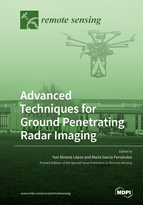Advanced Techniques for Ground Penetrating Radar Imaging
A special issue of Remote Sensing (ISSN 2072-4292). This special issue belongs to the section "Remote Sensing Image Processing".
Deadline for manuscript submissions: closed (30 April 2021) | Viewed by 43522
Special Issue Editors
Interests: antenna measurement; antenna diagnostics; inverse scattering; microwave imaging; ground-penetrating radar; indoor locations systems
Interests: inverse scattering; microwave imaging; ground penetrating radar; antenna measurement; unmanned aerial vehicles; positioning and geo-referring systems
Special Issues, Collections and Topics in MDPI journals
Special Issue Information
Dear Colleagues,
Ground-penetrating radar (GPR) has become one of the key technologies in subsurface sensing and, in general, in nondestructive testing (NDT), since it is able to detect both metallic and nonmetallic targets. Furthermore, it can also provide images from the underground, thus improving detection capabilities. GPR for NDT has been successfully introduced in a wide range of sectors, such as mining and geology (detection of cavities, mineral deposits), glaciology (measurement of ice thickness), civil engineering and civil works (detection of cracks and defects in infrastructure), archaeology, and security and defense (detection of buried landmines and improvised explosive devices).
In recent decades, improvements in georeferring and positioning systems have enabled the introduction of synthetic aperture radar (SAR) techniques in GPR systems, yielding GPR–SAR systems capable of providing high-resolution microwave images. In parallel, the radiofrequency front-end of GPR systems has been optimized in terms of compactness (e.g., smaller Tx/Rx antennas) and cost. These advances, combined with improvements in autonomous platforms, such as unmanned terrestrial and aerial vehicles, have fostered new fields of application for GPR, where fast and reliable detection capabilities are demanded. In addition, processing techniques have been improved, taking advantage of the research conducted in related fields like inverse scattering and imaging. As a result, novel and robust algorithms have been developed for clutter reduction, automatic target recognition, and efficient processing of large sets of measurements to enable real-time imaging, among others.
This Special Issue is intended to provide an overview of the state of the art in GPR imaging, focusing on the latest advances from both hardware and software perspectives. Review papers on GPR imaging are also welcome. Topics of interest include but are not limited to:
- Advances in GPR RF front-end: antenna design, antenna arrays, radar devices;
- Novel GPR architectures;
- Synthetic aperture radar techniques for GPR;
- Clutter mitigation algorithms;
- Motion compensation and autofocus techniques for GPR;
- Soil composition estimation;
- Multilayered techniques for GPR imaging (e.g., based on Green’s function of layered media);
- Compressed sensing techniques applied to GPR;
- Artificial Intelligence techniques for GPR images (e.g., automatic target recognition for landmine and IEDs detection).
Dr. Yuri Álvarez López
Ms. María García Fernández
Guest Editors
Manuscript Submission Information
Manuscripts should be submitted online at www.mdpi.com by registering and logging in to this website. Once you are registered, click here to go to the submission form. Manuscripts can be submitted until the deadline. All submissions that pass pre-check are peer-reviewed. Accepted papers will be published continuously in the journal (as soon as accepted) and will be listed together on the special issue website. Research articles, review articles as well as short communications are invited. For planned papers, a title and short abstract (about 100 words) can be sent to the Editorial Office for announcement on this website.
Submitted manuscripts should not have been published previously, nor be under consideration for publication elsewhere (except conference proceedings papers). All manuscripts are thoroughly refereed through a single-blind peer-review process. A guide for authors and other relevant information for submission of manuscripts is available on the Instructions for Authors page. Remote Sensing is an international peer-reviewed open access semimonthly journal published by MDPI.
Please visit the Instructions for Authors page before submitting a manuscript. The Article Processing Charge (APC) for publication in this open access journal is 2700 CHF (Swiss Francs). Submitted papers should be well formatted and use good English. Authors may use MDPI's English editing service prior to publication or during author revisions.
Keywords
- ground penetrating radar
- synthetic aperture radar
- clutter removal
- motion compensation
- soil composition
- multilayer media
- compressive sensing
- subsurface imaging
- landmine detection
- through-the-wall imaging






